 |
  Home | Contact | Site Map |

| Top Destinations |
|
You are here Home » Top Destinations » Alleppey Allapuzha
Honeymoon in Alleppey/Allapuzha, Kerala, India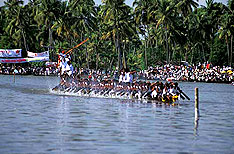 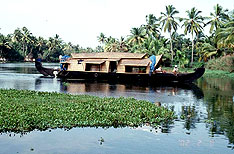 About Alleppey/Allapuzha Often called Venice of the East, Alappuzha is famous for its boat races, houseboat holidays, beaches, marine products and coir industry. Set in the labyrinth of backwater channels, the town is one of the best gateways to explore the inspirit countryside. A venue for the spectacular snake boat races, there is little else of interest. Alleppey offers relaxing boat cruises to Kollam along the small canals giving you the advantage of getting a closer look at the village life. A singular characteristic of this land is the region called Kuttanad where farming is done below sea level. Surrounded by coconut trees, Alappuzha is the headquarters of the coir industry of Kerala and an important center for cashew nut processing. HISTORYAlappuzha (also known as Alleppey) gets its historic name from the past of Kerala. Though the history of this region in the Paleolithic age is not clear, many believe that the coastal regions of Alappuzha were originally under water and later developed from the salt and silt deposits that helped give them shape. Kuttanadu dates back to the Sangam age and the early Cheras had their homes or Kuttuvans (today called houseboats) in Kuttanadu. Christianity spread in this region as early as the first century AD. Some of the churches are located at Chertala and it was founded by St Thomas, one of the 12 disciples of Jesus Christ. His presence made a tremendous impact on the region. Dramatic changes influenced Alappuzha once more in the ninth century. This was when the second Chera Empire propagated the spread of religion and culture. CULTUREThe Nehru Cup Snake Boat Race is a fascinating sight to catch on at Alleppey. This famous regatta on Vembanad Lake takes place on the second Saturday of August each year. Scores of long, low - slung chundan vallams compete for the Nehru Cup. Each boat is crewed by up to 100 rowers shaded by gleaming silk umbrellas. FOODAs for the cuisine of Kerala, with a few notable exceptions, it is mildly flavoured, gently cooked and sits with a certain genteel delicacy on the stomach. A case in point is the rich biryanis of the northern parts of Kerala: the Malabar biryanis. Pilaos, pilafs and biryanis are meats, spices and onions slowly steam-cooked in boiled rice. Thus all the goodness of the rice and the meat broth are locked into and blended in this dish which is served steaming hot. A favourite breakfast dish is poottu. Rice flour dough is layered with grated coconut, like a ribbon cake, and steamed in a hollow bamboo cylinder. It is eaten sprinkled with sugar, or with mashed bananas or with a spicy curry made of channa or chickpeas. lddlis or fluffy white steamed rice cakes, and dosas which look a bit like thin golden ornlettes but are really pancakes made of an yeasty rice-and-lentil batter, are popular in Kerala and very acceptable fare for there is reason to believe that they aren't strictly Malayali cuisine. Kerala does have its own, well developed, vegetarian cuisine. If you're there during the post-harvest festival of Onam do opt for a typical vegetarian Onam lunch. Its traditionally eaten on a banana leaf: very hygienic and disposable. Par-boiled rice is the staple for such a meal, as it is for most Kerala food, and then you ring the changes. A spoonful of rice, and then somethoren. Savour. A little avial with your next spoonful of rice. Or olen. Or kaallen. Or pachadi. A sip of water. Ahh! And then make the rounds all over again, in combinations now. In western food every dish, in a meal, is different; perhaps. In Indian cuisine, every mouthful is. SHOPPINGThe bazaar along the main street, at Mullakal road is where you will see mundu-clad men selling local groceries. You might want to take some of the ancient hand-crafted coir mats, yarns and mattings home. Take a look at the locally made carpets which are also worth a buy. ENTERTAINMENTChamundi HillPerched at a height of 1,050 m, Chamundi Hill is the abode of Goddess Chamundeswari - the patron goddess of the Wodeyar family. This temple gets its name from Goddess Kali or Chamundi, the consort of Shiva. The temple is a charming quadrangular structure with a towering 40 m high gopuram that is a landmark from several miles. A huge stucco figure of Mahisasura 3 1/2 m tall welcomes you at the entrance. Built in the 12th century, the temple is a fine representation of the Dravidian school of architecture. Its 1000 steps to the top, but take heart, there is a path to the top too. The temple is open 6.00 am to 2.00 pm, 3.30 pm to 6.30 pm and 7.30 pm to 9.00 pm. Pleasant for a half-day excursion. Entry Rs 10. Close by is the Godly Museum. Aptly titled, it houses a collection of exhibits that depict a good many moral lessons. You are told that you were probably here 5,000 years ago since everything in the universe repeats itself. En route is a stunning Nandi temple, which boasts of a 5 m high monolithic statue of Lord Shiva's revered bull. Carved out of a single stone in 1659, it is believed to be the largest in India, commissioned by Dodda Deva Raja, a devout Wodeyar king. Lalitha Mahal PalaceBuilt in 1921 by Maharaja Krishna Raja Wodeyar Bahaddur IV, this palace initially housed royal guests. Designed by E W Fritchley, an English architect, the palace is today a five-star hotel. Now a popular venue for local film shoots and other social gatherings, a visit to the palace may help you understand the mystique of royal Mysore. Folklore MuseumLocated in the Mysore University Campus, this museum has a spectacular collection of more than 6,500 unique folklore exhibits. Wooden figures from Karnataka villages, wooden and leather puppets and other interesting items from various villages around Karnataka are on display. Don't miss the carved wooden chariot. The first of its kind in India, the Rail Museum was set up in 1979. Situated at Krishnaraja Sagar Road, the museum sets a good pattern for regional display and has a good collection. The highlight here is the Chamundi Gallery that showcases a unique and interesting collection of photographs and paintings depicting the development of the railways. Don't miss the Sri Ranga Pavilion, which has two royal coaches. They belonged to the Maharaja of Mysore and have a certain old-world charm about them, harking back to a time when royalty travelled in splendour. Most of the exhibits in the museum once graced the Mysore palace. Of particular interest is the Maharani's saloon carriage that boasts of a kitchen, dining car unit and a royal toilet dating back to 1899. One of the first steam engines built, it is indeed remarkably well kept. There is also a battery-operated mini-train, which takes you for a fancy ride along the grounds. General Information of Alleppey/Allapuzha LOCATIONSeparated out from the former districts of Kottayam and Quilon, Alappuzha consists of seven taluks spread over an area of 1414 sq km. It is bounded by Kochi and Kanayannur taluks on its north; Vaikom, Kottayam, Changanassery Thiruvalla, Kozhencherry and Adoor taluks on its east; Kannathur and Karunagappally taluks on its south and the exotic Lakshadweep of the Arabian Sea on its west. How to Reach By AirAlappuzha is accessible by all the means of communication. The nearest airport is Kochi at a distance of 64 km north. The Trivandrum airport is located 159 km south of Alappuzha. By RailThe nearest railhead is Alleppey Railway Station at 5 km from the central bus stand and the boat jetty. Recently been linked to Cochin by rail, some trains link it to cities like Chennai and Bokaro. By RoadAlleppey is on the NH 47 highway and is connected to all-important towns in south India by public state transport buses. By SeaAlleppey is linked by boat services through the backwaters to Changanassery and Quilon (both trips particularly splendid), Kottayam, Cochin, Kumarakom, Kovalam and Chengannur. Frequent and inexpensive services originate from the boat jetty near the central bus stand. CLIMATE Alleppey has a typically tropical humid climate. Tourist Attractions in Alleppey/Allapuzha Sree Krishna temple
Rajarajeswari temple Located at the heart of Alleppey town, the presiding deity is Goddess Rajarajeswari. The temple celebrates two festivals every year. The nine-day Navarathri festival is especially important of which the last two days are most auspicious. Colorful processions participated by nine elephants are held in the evening. It is witnessed by thousands of devotees. Also several cultural programmers including Ottanthullal are staged in the temple. Mannarsala
Krishnapuram Palace The 18th century Krishnapuram Palace was built during the reign of the Travancore monarch, Martand. A double storied structure, it displays typical characteristics of Kerala architecture like gabled roofs, dormer windows, and narrow corridors. It houses one of the largest mural paintings in Kerala called the Gajendra Moksham. It measures14 feet by 11 feet and is at the western end of the ground floor, a walking distance from the Palace Pool. Inside is also a museum of antique sculptures, paintings and bronzes. Kochi
|
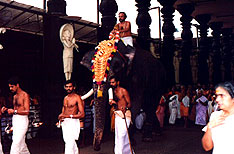 Situated 14 km. away at Ambalappuzha is the Sreekrishna temple. One of the most important temples in Kerala, its architectural features confirms the typical Kerala Style. The main festival is celebrated during March/April. The temple is famous throughout Kerala for Palpayasam, milk porridge of exceptional sweetness prepared in a very large quantity and offered to the deity. Poet Kunjan Nambiar who lived in the 16th century staged his first Ottam Thullal, a solo dance, in this temple auditorium.
Situated 14 km. away at Ambalappuzha is the Sreekrishna temple. One of the most important temples in Kerala, its architectural features confirms the typical Kerala Style. The main festival is celebrated during March/April. The temple is famous throughout Kerala for Palpayasam, milk porridge of exceptional sweetness prepared in a very large quantity and offered to the deity. Poet Kunjan Nambiar who lived in the 16th century staged his first Ottam Thullal, a solo dance, in this temple auditorium.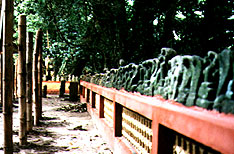 This beautiful temple dedicated to the King of Serpents is an important center off serpent worship in Kerala. It is located near Haripad on the Alleppey-Quilon route on a panoramic site measuring about 16 acres of thick green forest. It is a place of worship visited by large number of devotees from all over India. The temple with much religious fervour celebrates a two-day festival. On the second day by noon, the Ezhunnallathu (royal outing) ceremony is conducted when the idol of Nagaraja is carried by the priests and taken round the temple in a procession. A large crowd of devotees with urili (vessel) and colorful parasols participate in it. The entire jungle setting of the temple reverberates with the full-throated chanting in praise of the Serpent God.
This beautiful temple dedicated to the King of Serpents is an important center off serpent worship in Kerala. It is located near Haripad on the Alleppey-Quilon route on a panoramic site measuring about 16 acres of thick green forest. It is a place of worship visited by large number of devotees from all over India. The temple with much religious fervour celebrates a two-day festival. On the second day by noon, the Ezhunnallathu (royal outing) ceremony is conducted when the idol of Nagaraja is carried by the priests and taken round the temple in a procession. A large crowd of devotees with urili (vessel) and colorful parasols participate in it. The entire jungle setting of the temple reverberates with the full-throated chanting in praise of the Serpent God.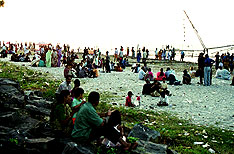 One of the finest natural harbors on the Arabian Sea coast, Kochi has been a port of call for foreign traders from early times. One of the most interesting towns is South India; its cosmopolitan character is reflected in its low rise, picturesque buildings and structures. A prime tourist destination and Keralas commercial hub; with its wealth of historical associations and its settings in a stunning location between the Arabian Sea and Backwaters, the city of Kochi perfectly reflects the eclecticism of Kerala. A city of peninsulas and islands, it is one of India's largest ports, a major naval base one of the finest natural harbors in the world.
One of the finest natural harbors on the Arabian Sea coast, Kochi has been a port of call for foreign traders from early times. One of the most interesting towns is South India; its cosmopolitan character is reflected in its low rise, picturesque buildings and structures. A prime tourist destination and Keralas commercial hub; with its wealth of historical associations and its settings in a stunning location between the Arabian Sea and Backwaters, the city of Kochi perfectly reflects the eclecticism of Kerala. A city of peninsulas and islands, it is one of India's largest ports, a major naval base one of the finest natural harbors in the world.